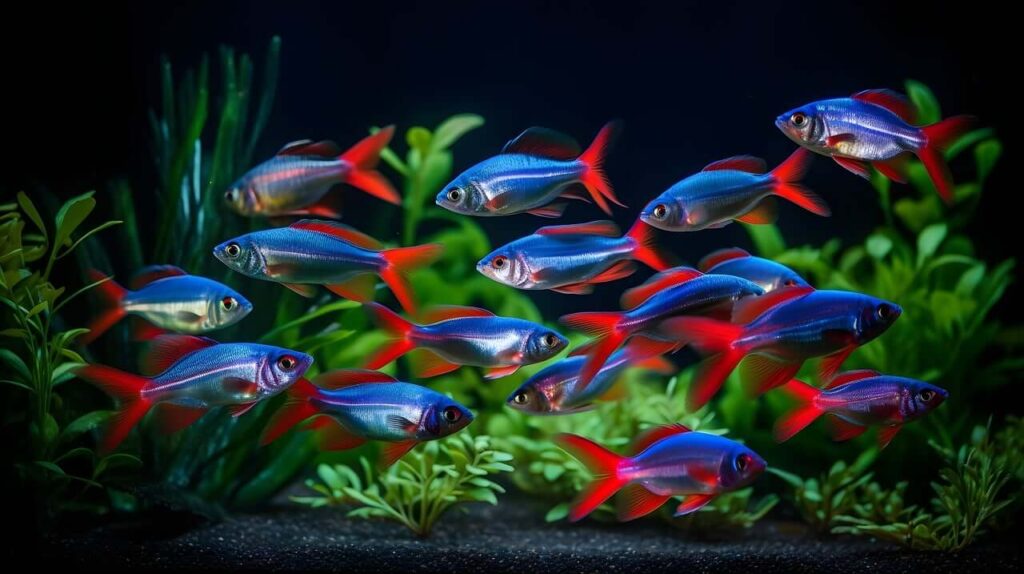Maintaining the ideal Tetra fish tank pH levels is important to the health and well-being of your fish. Tetras, with their vibrant colors and playful personalities, are a popular choice among aquarium hobbyists. However, to ensure their longevity and happiness, you must understand and manage the pH levels in your aquarium. In this guide, we’ll delve into the intricacies of Tetra fish tank pH levels, offering expert advice and valuable insights to help you create the perfect aquatic environment for your Tetras.
What is pH, and Why is it Important for Tetras?
pH stands for “potential of hydrogen,” and it measures the acidity or alkalinity of water on a scale from 0 to 14. A pH of 7 is considered neutral, while values below 7 indicate acidity, and values above 7 denote alkalinity. Tetras thrive in slightly acidic to neutral conditions, typically in the range of 6.5 to 7.8. Understanding the significance of pH levels for Tetras is essential because:
- Health and Vitality: Maintaining the right pH level ensures your Tetras remain healthy and vibrant. Extreme pH fluctuations can stress your fish and make them susceptible to diseases.
- Behavior and Reproduction: pH impacts the behavior of Tetras and can influence their breeding habits. Maintaining optimal pH levels encourages natural behaviors and breeding.
- Chemical Equilibrium: pH affects the chemical balance in your aquarium. Proper pH levels help prevent the leaching of harmful chemicals from substrates or decorations.
- Nutrient Availability: pH levels also impact the availability of essential nutrients in the water. Ensuring the right pH range enhances nutrient absorption for your Tetras.
Now that we understand the importance of Tetra fish tank pH levels, let’s dive deeper into managing pH levels in your aquarium.
Tetras Water Requirements
While most tetras are found in soft, acidic water in the wild, the majority of aquarium species sold today are raised commercially in water that often has a higher pH and alkalinity than their native environments. For most tetras, pH should be between 6.8 and 7.8, alkalinity between 3° and 8° dkH (50 ppm to 140 ppm) and temperature between 75° and 80° F.
Source: Aqueon
Factors Affecting Tetra Fish Tank pH Levels
Maintaining the right Tetra fish tank pH levels isn’t just about adjusting the water’s acidity or alkalinity; it involves a holistic approach. Several factors can influence the pH levels in your Tetra fish tank:
1. Water Source
The pH of your tap water can vary significantly depending on your location. Before filling your aquarium, test your tap water’s pH using a reliable aquarium pH test kit. This baseline reading will help you make appropriate adjustments.
2. Biological Processes
Nitrification: The nitrogen cycle in your aquarium can impact pH. Beneficial bacteria involved in nitrification can produce acids, lowering pH. Regular water changes and biological filtration can help stabilize pH levels.
3. Substrate and Decorations
The materials you use in your aquarium, such as gravel, rocks, or driftwood, can leach minerals into the water, affecting pH. Research your chosen substrate and decorations to ensure they align with your desired pH range.
4. Fish Load and Feeding
The number of Tetras in your tank and their feeding habits can influence pH. Overfeeding can lead to increased organic waste, which can lower pH due to the release of organic acids.
5. Chemical Additives
pH-adjusting chemicals are available in the market to either raise (buffer) or lower (acidify) pH levels. However, these should be used with caution and only when necessary, as they can cause rapid pH swings if misapplied.

Testing and Monitoring pH Levels
Maintaining a stable Tetra fish tank pH levels. Regular testing and monitoring ensure that you catch any fluctuations before they become detrimental. Here’s how you can do it:
1. pH Test Kits
Invest in a high-quality pH test kit that provides accurate readings. Liquid test kits are generally more reliable than test strips. Perform tests at least once a week and record the results.
2. Observe Tetra Behavior
Your Tetras’ behavior can provide valuable clues about the pH. If they appear lethargic, lose their color, or exhibit unusual behavior, it could signal a pH issue.
3. Track pH Trends
Maintain a log of pH readings over time. This will help you identify patterns or gradual changes in pH, allowing you to take preventive measures.
Adjusting Tetra Fish Tank pH Levels
If you find that your Tetra fish tank pH levels are outside the ideal range for Tetras, you may need to make adjustments. Here are some methods to consider:
1. Water Changes
Perform regular water changes using dechlorinated water that matches the desired pH range. Gradual changes are less stressful for Tetras than abrupt adjustments.
2. Use pH Buffering Substrates
Select substrates like crushed coral or limestone that naturally buffer the pH towards the desired range. These substrates slowly release minerals that stabilize pH.
3. Driftwood and Peat Moss
Incorporating driftwood or peat moss into your aquarium can help lower pH. These natural materials release tannins and organic acids, creating a slightly acidic environment.
4. Commercial pH Adjusters
If necessary, you can use pH-adjusting products designed specifically for aquariums. However, exercise caution when using these products, as overdosing can lead to sudden pH swings.
Tetra-Specific pH Considerations
Tetras, being sensitive fish, require specific attention when it comes to pH management. Here are some Tetra-specific pH considerations:
1. Soft Water Tetras
Species like Cardinal Tetras and Neon Tetras thrive in soft water conditions with slightly acidic pH. Aim for a pH range of 6.0 to 6.5 for these Tetras to mimic their natural habitat.
2. Hard Water Tetras
Tetras like Serpae Tetras and Black Skirt Tetras are more adaptable to slightly alkaline water. Aim for a pH range of 7.0 to 7.5 for these species.
3. Gradual Changes
Whether adjusting pH up or down, always make changes gradually. Rapid pH swings can shock and harm your Tetras. Slowly acclimate them to the new conditions over several days.
4. Breeding Tetras
If you intend to breed Tetras, maintaining stable pH levels is crucial. Slight acidity is often preferred for successful breeding, so monitor and adjust accordingly.
Troubleshooting Common Tetra fish tank pH levels issues
Despite your best efforts, you may encounter Tetra fish tank pH levels issues. Here are some common issues and their solutions:
1. High pH (Alkaline)
Issue: High pH can stress Tetras, making them susceptible to diseases.
Solution: Perform regular water changes with pH-adjusted water, use pH-lowering substrates, or add driftwood to reduce pH gradually.
2. Low pH (Acidic)
Issue: Low pH can lead to reduced fish activity and slower metabolism.
Solution: Gradually raise pH by using crushed coral or commercial pH-raising products, but avoid sudden increases.
3. pH Fluctuations
Issue: Rapid pH swings can be lethal for Tetras.
Solution: Maintain stable conditions through consistent water changes, proper filtration, and monitoring.
Tetra fish tank pH levels can sometimes become too low, posing a challenge for fishkeepers. It’s crucial to maintain the appropriate pH range for specific Tetra species. Neon Tetras are known to thrive in slightly acidic water with a pH range of around 6.0 to 7.0. Glofish Tetras, which are genetically modified Tetras, can adapt to a similar pH range as Neons. Tetra fish tank pH levels On the other hand, Cardinal Tetras prefer a more acidic environment, typically around 5.0 to 7.0. To cater to these preferences, you might need to adjust your aquarium’s pH levels.
If your pH is too high, you can lower it by various means. One common method is to use pH-lowering substrates or driftwood, which release tannins and organic acids, gradually reducing pH levels. Additionally, performing water changes with slightly more acidic water can help lower pH over time. However, always make changes gradually to avoid shocking your Tetras.
Regarding tetra fish tank size, it’s essential to provide adequate space. A general rule of thumb is to allow at least one gallon of water per inch of adult Tetra. However, the specific tank size can vary based on the Tetra species and the number of fish you intend to keep.
Lastly, Glow Tetra fish care is similar to that of other Tetra species. They require appropriate pH levels, a well-maintained tank, and a balanced diet. Ensuring a stress-free environment, including suitable tankmates and hiding spots, contributes to their well-being. Remember that maintaining stable water parameters, including pH, is key to the care of all Tetra species, including Glofish Tetras.
Conclusion
Achieving and maintaining the right Tetra fish tank pH levels is essential for the health, behavior, and longevity of your fish. Regular testing, careful observation, and appropriate adjustments will help











